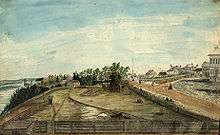Wellington Street (Ottawa)


Wellington Street (French: Rue Wellington) is a major street in Ottawa, notable for being one of the first two streets laid out in Bytown in 1826 (the other being the eastern leg of Wellington, Rideau Street), but also because of the adjacent Parliamentary Precinct. The street runs from Booth Street to the Rideau Canal where it connects with Rideau Street and delimits the northern border of the downtown core. It is named after the Duke of Wellington, in recognition of his role in the creation of the Rideau Canal, and therefore of Ottawa (see History of Ottawa).[1]
Starting at its easternmost point, Wellington forms the northern edge of Confederation Square, south of which runs Elgin Street. West of Confederation Square, Parliament Hill can be found on its north side, while the Langevin Block, home of the Prime Minister's Office and of the Privy Council Office, the former American embassy and the Wellington Building can be found to the south. West of the intersection with Bank Street, are located the Confederation Building and the Justice Building (still considered within the Parliamentary Precinct), while the headquarters of the Bank of Canada can be found opposite the Hill.
Beyond Parliament Hill, the Supreme Court of Canada is situated west of the Justice building, and opposite St. Andrew's Presbyterian Church. The East and West Memorial Buildings can be seen next, respectively standing east and west of Lyon Street and linked by the Memorial Arch. West of the Supreme Court is the National Library and Archives of Canada main building, with the Garden of the Provinces across the street. Between the Supreme Court and the National Library is a large open area that is today a mix of park land and large parking lots. Until the 1970s this was home to a cluster of temporary buildings that had been erected in the Second World War to provide much needed office space. In the 1970s there was a plan to build both a home for the Federal Court and the National Gallery. A design competition was even held for the National Gallery, but in the end the government cancelled both projects.
Wellington Street continues west past the Portage Bridge, north of the eastern half of the Lebreton Flats, and becomes the Sir John A. Macdonald Parkway after crossing Booth Street at the Canadian War Museum.
West of the O-Train Bayview station, a separate segment (originally an extension of the same street) is known as Wellington Street West, and passes through the Hintonburg and Island Park neighbourhoods before becoming Richmond Road at Island Park Drive.
Both sections of Wellington are four-lane historic urban arterial roads with a speed limit of 50 km/h (30 mph), although the flow is generally even slower than that due to high pedestrian traffic.
A number of proposals have been made to change the street's name (to honour Sir John A. Macdonald or Pierre E. Trudeau, for example), some as recent as 2010.[2]
From Bronson Avenue until Rideau Street, Wellington is also known as Ottawa Road #34. From Western Avenue to Somerset Street, Wellington is known as Ottawa Road #36.
Map
Wellington Street from Bay Street to the Rideau Canal showing the prominent structures located along it. See Downtown Ottawa for a map of the entire area.
Sources
- "City of Ottawa map showing Wellington Street downtown" (PDF). (1.49 MiB), accessed 15 November 2006
- West Wellington Community Association, accessed 15 November 2006